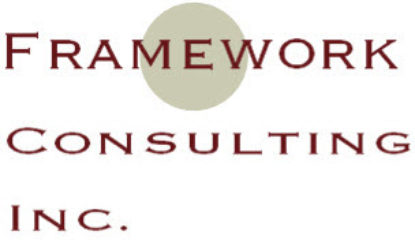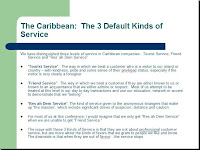 In our development of a new, Caribbean-based approach to Time Management, I have stumbled across what I think is an irreducible framework lying behind all efforts to improve productivity. It may well provide the basis for a flexible kind of system that anyone can create for themselves.
In our development of a new, Caribbean-based approach to Time Management, I have stumbled across what I think is an irreducible framework lying behind all efforts to improve productivity. It may well provide the basis for a flexible kind of system that anyone can create for themselves.
In the same way that ALL bicycles are designed in a particular way in keeping with certain physical laws,
all time management systems must account for certain basic facts of how time is used and experienced by humans. For example, not being able to be in 2 different places at the same time is a simple law that many of us try to break, but are not able to, despite our crazy efforts. Also, it is impossible to leave Diego Martin to get to Arima, or from Barbican to get to Spanish Town for a 3:00pm appointment by leaving at 3:00pm.
While the system may be customized and enhanced and tailored and even automated, it still must make a certain kind of basic sense to each and every user, regardless of profession.
(For the purposes of this discussion, all the stuff that flies at us each day in the form of requests, appointments, email, voicemail, new ideas that pop into our heads, bills, etc. are called “time demands.”)
A functional Time Management system needs to be reliable in:
- Capturing: temporarily storing information related to new time demands in a reliable place or places. Possible candidates for “reliable” places include our memory, email inbox or Post-It notes. For example, our daughter tells us to call her cell at 890-6543 at 3pm on March 16 (2 weeks from today) to give her directions. We could use any of the three places listed above to temporarily store the critical information.
- Emptying: moving information on new time demands from the place of capture, to another place where it can more reliably help us to act at the right time. The act of emptying is a decision point — when do we empty the “reliable place of capture” and what do we do with the information?
To continue the example above, do we trust ourselves to remember to call at the right time, and just memorize the information and create a mental reminder? Or do we sit down at our computers and convert the email into a reminder with an alarm on the morning of the call? Or do we take the Post-It Note with the information and stick in on the fridge or on the screen of our computer? These are just a few of the choices that we have.
The following steps all come after the decisions based on Emptying.
2a) Tossing: throwing away information we don’t need. In our example, it could mean taking the Post-It note off the fridge after the appointment, and tossing it in the garbage.
2b) Storing: putting away useful data for later use, in a safe place that we can later find. Some bad examples include putting a Post-It note in a drawer with 100 other bits of random paper, leaving an email in an inbox of 4000 other un-read emails or just hoping that we can remember the numbers she told us. A much better example would be to place her cell number under her name in Outlook Contacts. A good storage place allows us to find the right information at the right time.
2c) Scheduling: allotting time in our calendar to make the call. This is a way to help ourselves to plan our time properly. This personal appointment could help us to to plan the afternoon of that day. For example, our boss might come to us after lunch on the 14th to set up a 2:45pm meeting. To prevent a problem, we would check our calendar before committing to a meeting longer than 15 minutes. Having a calendar is one way to deal with it — another is to hope that we remember.
2d) Acting Now: taking immediate action. We might decide to take an immediate action so that we can forget about the issue altogether. In the example above one option would be to spend 5 minutes sending her an email with the directions. Another option would be to call her brother and ask him to go with her instead. another would be to call her voicemail on her cell, and leave her detailed directions that she can use on the 16th. In any of these cases, we could forget about this particular time demand.
2e) Listing: placing a time demand on a list for later use. We could add the information to a list of items. we might add it to a list of things to do that day, a list with her name on it or a list of phone calls to make that week. Of course, we could just try to remember it, and hope that our memory kicks in at the right moment in time, with the right information.
Not only would a functional time Management System need to do all these things, it would also need to be able to monitor itself to ensure that it doesn’t break. The way to do that is ensure that it can do the following functions, and also be reliable in:
- Reviewing: setting up appointments to look over the system to make sure that it is working well. An example would be to look over the week’s appointments to ensure that there is sufficient time to travel from one to another.
- Switching: moving from one appointment to another, ensuring that the prior activity is complete, and wisely choosing the next activity subject to factors such as interest level, available energy, time of day, etc. One practice that some users have is to schedule meetings at least 15 minutes apart to allow themselves to mentally and physically regroup.
- Warning: sending a signal to the user that a piece of the system is near the breaking point. At any time, the system could break from a variety of causes — sometimes just due to user oversight. For example, the system could be set up to warn the user when the list of items to be done on a particular day exceeds 50. if the warning came early enough, the user could decide to re-schedule the items on the list for that day.
- Interrupting: creating an audible or physical interruption that cannot be ignored, advising the user that they must stop what they are doing or else they might create a problem with their appointments. The simplest alarm that many people use is one to interrupt their sleep in the morning. Other examples include alarms built into the Outlook Calendar, an egg-timer with a loud ring or even a scheduled cell-phone reminder.
These elements are the basic capabilities of any Time Management system. Any system that does not account for one or more of these distinct elements, fails to meet one of the requirements of the busy professional.
Most people’s systems (developed during their late teens and early twenties)are well beyond the breaking point, as the number of items that they need to capture and put into their system has overwhelmed their habits. To put it simply, their “systems” were not designed to deal with the level of complexity their lives have attained. The result is an increase in stress.
A good system must be flexible enough to deal with not only increases in volume, but also changes in technology. As new tools are created and introduced, they can help professionals to be more efficient if applied wisely. For many people, however, their email inboxes have just become another burden.
Once the basic requirements have been understood, a user can design a system using as much technology as they want to meet their needs.










